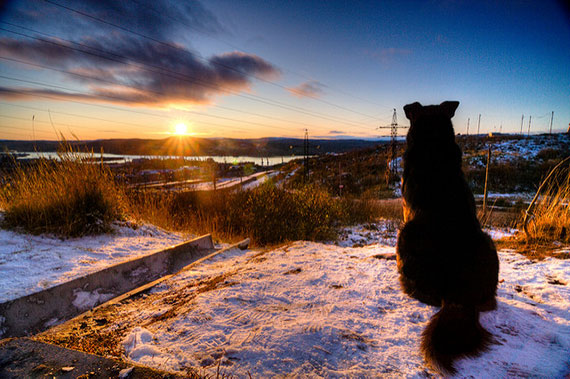One aspect of photography that photographers constantly strive to improve is composition. It’s one of those things that you spend your entire photographic career working on. There are many considerations to be made on what to include in the frame and—equally important—what to leave out, and it can sometimes be a little overwhelming trying to get the hang of it.
There are, however, some simple rules that we can follow to help compose stronger, more interesting images.

Photo by Tom Thiel; ISO 100, f/8.0, 1/200-second exposure.
Horizon
The position of the horizon can have a huge impact on an image. It can direct interest to the foreground if there’s a dominant element in this part of the frame, or it can make a big sky look even bigger and add a sense of scale. Position your horizon for a reason. You can do this by deciding what the focal point of your image is. (i.e. what your image is about). If you want to show an approaching storm over a mountain ridge, then you might place your horizon at the bottom of the frame to allow the storm clouds to dominate.
If however, your image is about the mountain range itself, then positioning the horizon higher in the frame will show the height of the mountains and show their relation to the foreground in front of you.
It’s often said that you should avoid positioning the horizon in the center of the frame, as this can create confusion about the focal point of the image. Is it about the approaching storm or the mountain range? This is generally a good rule to follow, however, as with most rules in photography, there is always a time where it can be broken. Sometimes all the elements within the frame just balance better with the horizon in the center. This is where instinct comes in. If your horizon simply feels better in the center, then leave it there.
Lines
Photographs are composed of a series of lines. Straight lines and curved, horizontal, vertical and angled. Understanding the lines in your image and using them to your advantage can help you create much stronger images. All lines start and end somewhere, such as the converging lines of a road leading into your image, which can imply a journey or distance. Lines that are neither horizontal or vertical give an image a feeling of energy, while an image comprised of dominant horizontal and vertical lines has a more static feel. Curved lines soften an image and can change the mood of a photograph altogether to something more relaxing or tranquil.
Combining these lines within a photograph gives you shapes. Each shape within the frame interacts with each other shape and the frame itself. Learning to see how these shapes interact with each other allows you to focus more clearly on the elements that help to tell your story—and leave out those that don’t. This is quite a difficult thing to do as it requires you to detach yourself from a scene and view it only as a series of shapes or lines, but once practiced it becomes second nature. Before long you’ll be doing it without thinking.

Photo by Mark Shahaf; ISO 400, f/5.6, 1/1600-second exposure.
Aspect Ratio
While considering what goes into the frame, also consider the frame itself. Most cameras have a 3:2 aspect ratio, which means that the horizontal side of the frame is half again longer than the vertical side. This doesn’t necessarily mean that every photograph you make needs to have these dimensions. In the case of the mountain range discussed earlier, you might decide that a more panoramic shape works better to show the scale of the mountains. Or if you’re photographing portraits or still life, a square frame may give better balance to the lines and shapes of the image. Digital photography and post processing software allows you to crop and adjust the frame easily to find the balance that suits your image.
Understanding and practicing the techniques above regularly helps to give you a clearer idea of what story you wish to tell when you make your photographs, and the best way in which to do this—and this is when we can make our images stronger.
About the Author:
Mark Eden is a freelance travel photographer and writer, who creates images and articles for various print and digital publications. Expanse Photography is his website and blog.
Like This Article?
Don't Miss The Next One!
Join over 100,000 photographers of all experience levels who receive our free photography tips and articles to stay current:






I would like to add: “Practice, practice, practice”. By any means, start with “rules” of composition, we all had to start somewhere to help us learn what “works” and what doesn’t. But at some point, rules have to be seen as flexible guidelines. To get to the next stage of artistic expression, you will have to “feel” yourself into the composition rather than aply clearcut rules.
This seems daunting at the beginning, but try not to overthink it. With practice, you will start to recognize the visual elements automatically and this in turn will give you the freedom to think beyond what is in front of you.
I started DSLR photography 2 years ago, and with my engineering background I encounter no significant problems with the physics and maths of photography; although I keep ‘discovering’ new facets of my Nikon D7000 almost everyday! BUT I find correct composition the toughest part of the shooting.
The first sentence of the article – although it is an effective opener – lacks that precious small phrase: ‘….and make no mistake about it, that improvement is a lifetime affair’.
I also suggest such a refreshing article should be aimed particularly at beginners, like me. The heading could emphasize that by reading PHOTO COMPOSITION TIPS FOR BEGINNERS.
Warm regards from Mauritius